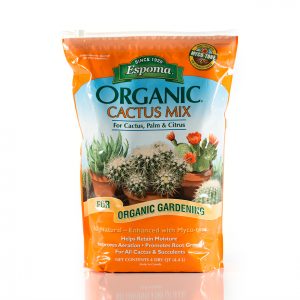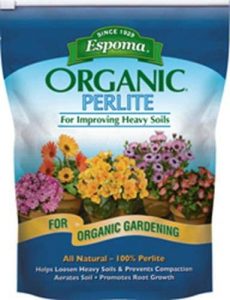The difference between the best soils and an average one is drastic. Many owners make the mistake of just buying any potting medium, which quickly results in dying fiddle leaf fig trees. Trust me, you don’t want to find out too late by seeing your tree’s leaves falling off.
The soil that your fig tree sits in is vital to its survival. That is why its important to have the best one possible. Having great loam will set your tree up for success. Conversely, if you it is of poor quality, you will struggle to keep your tree alive more than a couple months. By the time you have developed root rot, it will be difficult to reverse the bad effects of the root disease.
We have plenty of other articles on growing bushes and trees. Make sure to also check out our guide on successfully raising a fiddle leaf fig tree at home.
Here are the best brands that we recommend.
Comparing Our Top 2 Recommendations
At a Glance
- OUR TOP CHOICEPerfect Plants’ Fiddle Leaf Fig Soil
- Epsoma Organic Cactus Mix
- Epsoma Organic Vermiculite
- Fox Farm Ocean Forest Organic Potting Soil
- Epsoma Organic Perlite
These are our top recommendations. These mediums are well draining and will help minimize the chance of root rot.
Please note that for the the last three options above, they are meant to be mixed. We will go more into this further below.

Best Soils Mixes
Perfect Plants’ Fiddle Leaf Fig Soil
Perfect Plants’ product is designed specifically to provide the perfect medium to help fycus lyrata plants grow strong and healthy. It is lightweight, so it won’t damage the fig’s delicate root system. The loam also offers the ideal drainage control because it is made with coconut coir. This natural substance helps to wick moisture away from the roots while also retaining water in order to keep plants hydrated. The potting medium also contains a balanced mix of nutrients.
Epsoma Organic Cactus Mix
Epsoma Organic Cactus Mix is a potting medium that is designed to help plants retain moisture while also keeping roots from becoming too damp. This well-draining soil with moisture retention is ideal. The air flow around the roots that the loam provides also helps to promote root growth, which leads to stronger, healthier plants overall. The mix also contains natural ingredients that help to adjust the pH level. Gardeners who use this potting mix for their plants will find that the roots and stems are stronger, the plant is sturdier, and the foliage is fuller.

Epsoma Organic Vermiculite
For gardeners who are looking to enhance the drainage and nutrient qualities of their potting medium, Epsoma Organic Vermiculite is an excellent addition. This vermiculite, which is all natural, helps to loosen heavy or dense loam and increases drainage. It can also help to prevent compaction in soil, particularly in houseplants. The vermiculite also helps to increase airflow around a plant’s roots. This leads to faster, stronger root growth, which in turn leads to plants that are healthier overall. In addition, vermiculite helps to retain water, so plants will receive excellent aeration without drying out.
Fox Farm Ocean Forest Organic Potting Soil
Fox Farm Ocean Forest Organic Potting Mix contains a balanced mix of ingredients that offer plants the nutrients they require in order to thrive. This product contains natural bat guano, crab meal, sea-going fish, and earthworm castings, all of which contain essential nutrients that lead to stronger roots, healthier trunks and stems, and fuller, more richly colored foliage. The mix also contains sandy loam, sphagnum peat moss, and forest humus for a good balance of water retention and drainage. In addition, the potting medium is lightweight, so it won’t damage delicate roots.
Epsoma Organic Perlite
When added to dense or heavy soils, Epsoma Organic Perlite helps to lighten the dirt, creating a medium that retains water well but also aerates roots. The addition of perlite can also help to prevent compaction, which often occurs in houseplants. The perlite, which is all natural, also helps to promote better drainage, so plants will not experience root rot. The addition of perlite can actually assist in increasing root growth. Gardeners will find that plants with stronger roots often grow more quickly and are healthier overall.

We also recommend check out our saucer magnolia tree care guide.
Ficus Lyrata Repotting Guide
Fiddle Leaf Fig Trees are magnificent plants that can become the center piece to any room. Their vibrant green leaves create a light and elegant atmosphere. Some owners think that they are hard to successfully grow, but they really shouldn’t be with the right fertilizer and potting medium.
The soil you choose may be one of the most important decisions you can make for your fiddle leaf fig tree. Fast draining soils allow the water to reach the deep roots quickly and then give the roots proper aeration. If water is allowed to just sit near the roots, the roots can develop diseases. Poor root aeration can bring fungus or bacteria to your plant’s root system.
Soil obviously provide a place for roots to anchor to support the plant. However, it also serves as the medium by which nutrients reach the roots for growth and photosynthesis and deliver water to the roots.

Qualities of Good Potting Mediums
The ideal dirt is fast-draining. This will minimize the risk of root rot. Root rot, or root disease, is a condition that, if left untreated, will kill your fiddle leaf fig tree. It is hard to spot root rot because it occurs in the dirt – where it can slowly fester unbeknowst to the gardener. Most of the time, gardeners will not be aware of the problem until it is advanced.
When plants start to show symptoms of root rot, they will notice slowed growth, yellowing leaves, and ultimately slow plant death. Action needs to be taken immediately by these stages.
By the time root rot reaches advanced stages, it can be hard to treat. That is why preventing root rot is imperative. This can be done with soil that drains well. If it doesn’t drain water efficiently, it will put the roots at risk for root rot. When a plant’s roots sit in moist water, it becomes an area where harmful bacteria and organisms can live. This leads to root rot.

Soil Mixture Recipe
If you are making your own potting medium, I recommend taking using this mix: 1 part indoor potting soil, 1 part perlite, and 1 part vermiculite.
If you want to make things easier for yourself, then I highly recommend just buying one of the products above. It not only makes it easier for you, but it also takes out the guesswork. As you may know, fiddle leaf fig trees can sometimes be finicky and are not always the easiest plants to keep healthy. By minimizing variables, you increase your chances of success.
When to Repot
You should consider repotting when you notice that the roots are growing out of the drainage holes. Another method is to pull your ficus lyrata out of its pot and see if the roots are forming a dense root ball mass at the bottom of the pot.
Usually fiddle leaf fig trees need to be repotted every 1-2 years.
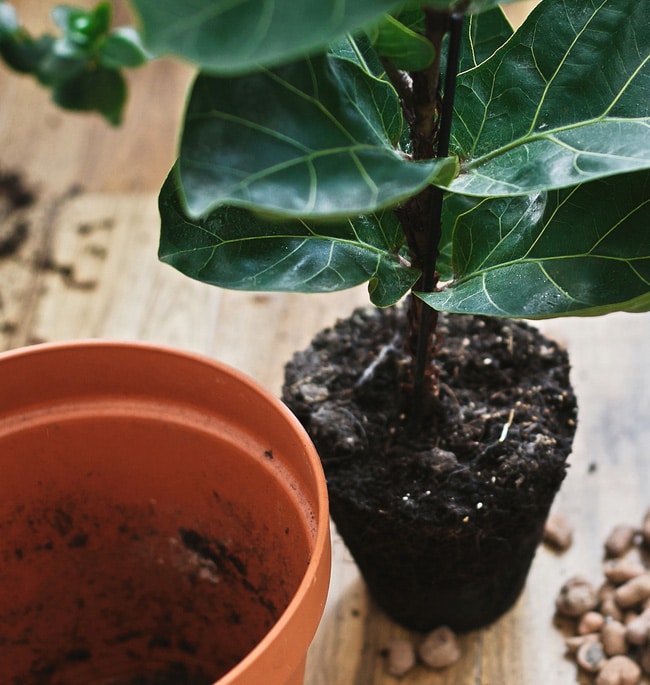

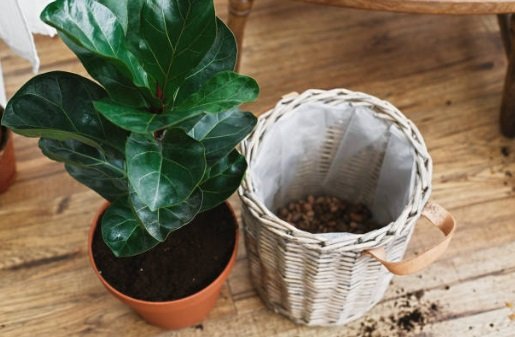
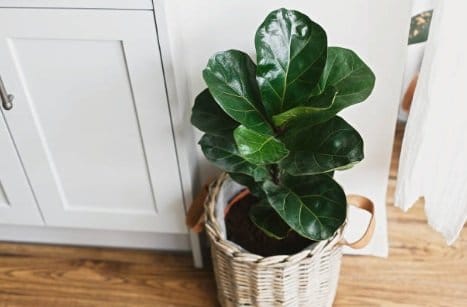
Repotting Instructions
Repotting fiddle leaf fig trees does not have to be hard. If you do plan on repotting your fiddle leaf fig, make sure you do in the spring. I advise against repotting during the winter when your tree is in a dormant stage. By repotting in the spring, you take advantage of the trees natural growth cycle.
To repot your tree, find a planter pot. Make sure the planter is at least 2-3” large than your existing pot. I personally recommend that you find a planter with a draining hole. I know, what you must be thinking – it does not have the aesthetics of a planter without a draining hole. Nonetheless, allowing the water to drain helps to prevent certain diseases due to excess moisture at the root zones. If you think a pot without a draining hole, you can imagine that the water is stuck at the bottom of the pot with nowhere to escape to.
Fill the bottom of your planter with soil. Remove your tree from its existing pot and put it into the new planter. I recommend either doing this outside because this can get messy. Usually, if you gently pull at the base of the trunk, the whole rootball should come out at once.
Put it in the middle of the new planter and then put in more dirt around the plant. Gently compact the dirt so that with the first watering you don’t have to bring out more dirt to fill in the edges.

Bottom Line
Again, I recommend buying the Perfect Plant’s Potting Mix. Don’t make the mistake of using a poor draining potting medium that you bought at your local gardening store. This will simply result in many more issues down the road.



